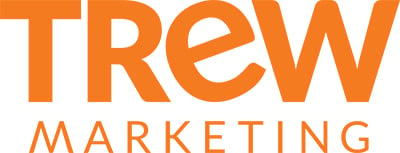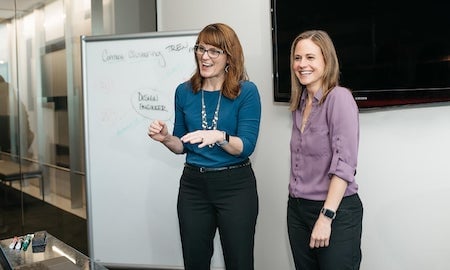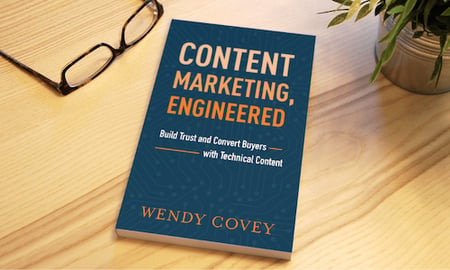Understanding the customer, taking on one initiative at a time, and measuring results were key to ushering inbound marketing into an Acoustic Engineering company.
Sabrina De Veylder-Pahwa, R2Sonic Marketing Director, has accomplished something which many industry peers struggle greatly with -- shifting her highly technical engineering company into an inbound marketing model. During this episode, she shares her journey, including the fantastic results they've achieved.
One of the most interesting parts of this episode was hearing about the close relationship she has with the global sales and technical support teams. R2Sonic invested in a sales enablement platform where Sabrina can efficiently share content, and salespeople know they have the latest assets at their fingertips.
You'll also hear about website improvements, content assets that perform well, and which vehicles Sabrina has found most and least effective for promotion.
Resources
- R2Sonic
- Sabrina on LinkedIn
- Blog post: The ROI of Content Marketing
- Podcast episode: The Annuity of Inbound Marketing with JD Sherman
Transcript
The following transcript was created by an AI Bot which has yet to learn slang words and decipher Wendy's Texas accent. While it is no substitute for watching/listening to the episode, transcripts are handy for a quick scan. Enjoy!
On today's episode, you'll hear from a marketing director of a highly technical company who introduced inbound marketing this past year. We'll talk about how she convinced leadership to invest in inbound marketing, what steps she took first, which may surprise you because they started with sales enablement and the success that the company has had through inbound marketing and where they're investing in 2021. It's a very interesting episode, full of great advice, particularly those who are struggling, trying to get traction internally to adopt inbound marketing as a model.
Let's do this. Welcome to Content Marketing, Engineered. Your source for building trust and generating demand with technical content. Here is your host, Wendy Covey.
Hi and welcome to Content Marketing, Engineered. on each episode, I'll break down an industry trend challenge or best practice in reaching technical audiences. You meet colleagues, friends and clients of mine who will stop by to share their stories.
And I hope that we each episode feeling inspired and ready to take action. Before we jump in, I'd like to give a shout out to my agency. True Marketing Crew is a full service agency located in beautiful Austin, Texas, serving highly technical companies. For more information, visit True Marketing Dotcom. And now on with our podcast.
Hey, everyone, I'm here with Sabrina Dan Builder, POWA. I'm sure I got that wrong.
Let me try it again, Sabrina. They build her power. She's the marketing director of Artesunate. Thank you for being here, Sabrina.
Thank you for having me. And I know I did a terrible job just then. How do you pronounce your name? Sabrina defended power.
You did it right.
OK, good, good. I was practicing and I got nervous and, you know, you never know. Tell me the origin of your last name.
So a developer is it was my father's last name says from Belgium and then Power, it's my husband's and he is Indian.
What an interesting combination right there. I kind of suspected of this, so I love it. It's very memorable. Right.
Well, I'm so excited to have you on today because I know you are a one person marketing dynamo and an engineering company, and it's a tough place to be being the the sole person. And on top of that, you've helped your organization move into an inbound marketing model. And I know there's a lot of people listening who are on this journey, too, and would like to just hear about how that went so we can have a good time talking about that.
But before we do, just give us some context about your company and what you do and your role as marketing director.
Right. So our two Solnik is one of the leaders in designing and manufacturing sonar's and particularly shallow water sonar's. And we're based here in Austin, Texas, and then me as a director of marketing. So I'm responsible for all the marketing activities, starting from defining the marketing plan based on business goals and then implementing really all the different strategies and tactics associated with that, whether it's product marketing, sales enablement, digital marketing, demand generation, all of the above, everything with the same thing in mind, which is try to contribute to growth.
It's a busy job right there.
Yes. So so let's talk about email marketing. When did you guys make a shift in this direction and how did it come about?
Yeah, so the quick answer is we started roughly a year ago, which was very fortunate because it was really great timing given the situation with covid. Right. But to give you a little bit of background, how everything came about. So when I joined, so we were very we have a very technical product and with very technical products, usually you can end up having very complex messaging and positioning, which ends up being difficult for everybody, whether it is your customers, but also your sales team.
Right. So we have we really had an opportunity to simplify as much as possible that messaging to make it easier internally on our sales team and on our customers. So I first started with internally with the sales team and what we did, we implemented a platform where everybody I mean, everybody, meaning the sales team from everywhere, could connect on that platform and had access to all the sales enablement and marketing collateral material. Right. And since we're a global company, that means a lot because not only they had access to the latest information at any time without wondering, is this the latest version or not?
And then if it's daytime in Japan and we're asleep here, then it doesn't matter. They have it right away. Right. So we implemented that. And then the content that we uploaded, we also simplified the content and shifted slightly to make it more customer focused. So what's in it for the customer type of question that we always had in mind? Right. So when we had that in place was sales team was better equipped, especially globally. So then we were able to transfer that.
OK, what does it mean for our customer? How do we do this? Right. And so we started improving our digital presence. And first place to start is obviously to update our website. So we leave the time.
Was the website pretty sad shape?
OK, you know, it was not too bad in the sense that it was not a website from kind of early two thousand or Faina.
It was not that old, but so it looked relatively new. But in terms of content, we had an opportunity to improve it in different ways, make it way more customer focus. It was really product. Here is my product here. All the specs and go figure it out, Mr. Customer. Right. So we had an opportunity to speak more from the customer's perspective. Give customers the. Opportunity to engage with us all along. Quick call to action all along within the on the website and then continue with this educational content.
And this is where inbound marketing comes into play, really trying to help customers with understanding how to best use our sonar's. Right. And helping them do their job, really, regardless of whether it was with us or our competitors. Really. So really, this is where the inbound initiative came into play. Now, obviously, once it's out, there is good, but then you need to make people aware of it. And so we after that, we implemented HubSpot as a marketing automation platform which helped us start nurturing our our contacts, whether they were subscribers or customers, leads, et cetera, and really started engaging in that communication.
And so HubSpot was a perfect tool for that, as now we had all this content available online. So it's a long answer, but hopefully to give you the story of how everything happens.
Oh, it's a really good story. And and so now I'm going to circle back to a few things you said and ask more questions. So first, I find it really interesting that you started with the internal content repository for sales, and I think that's brilliant.
But I like to hear a little bit of why, because I think that often companies start with their website and say, OK, salespeople get get your stuff off the website. But you and I know that there's many assets that you want sales to have. It aren't necessarily for public view. So was that the driver or was there know interest from sales to start there?
It was mostly what you said, which is there's all obviously content that you don't necessarily want to put out there for customers and they're more helpful to the sales team. So competitive analysis or battle cards, these kind of things. Right. So when I joined our two Sonic, a lot of that content already existed. So it's not that we did everything new. However, when I started talking to some of the salespeople globally, one of the challenges was, well, I'm not sure I have the latest version.
Can you send me this?
And so so it was big efficiency for you to email me, go to one place. Exactly there. I promise. It's all up to date. Yeah.
And then so it's a little bit more than just a repository of documents or videos or images. We have features where people, those salespeople can communicate as well. So there's a little bit of a chat there that we implemented. And we also shared some news that we thought were relevant across different sales team. So it was just a little ads on that. We're valuable as well for for everybody. Yeah.
Yeah. What can you share what platform you're using for that? So it's called Clara Mentis C, A or M NDIS. It's you know, it's one of the things that it's you have a ton of different tools available. And that one I find was very intuitive to set up, very easy to have all these different types of content available. And I liked having that little chat there. So for now, when I communicate with that sales team, I usually do it from that platform because they all in there and it's just much easier for me to do it that way.
It sounds like you've had a very six had a lot of success getting sales to adopt this tool to. Yeah, yeah. Absolutely wonderful because.
Right. That's that's more than half the battle, I imagine. Just CRM. What good is the CRM of sales. Is it using it. Absolutely. Absolutely.
Do you use this tool also to gain sales feedback on things like contin or what what new assets they might find useful?
They so usually what happens is if I share something with them from that platform, they would respond to me via email or they'll get a call, OK? And so they don't necessarily use the platform to get in touch with me, but they obviously use it and provide a direct feedback. So it helps actually at least drive that conversation. Conversation, yeah, absolutely. What's the number one sales piece that everyone just loves?
You know, I think it's not going to be very original, but. You know, the spec sheet is ultimately what people go to. Yeah, we optimize our website. What we're actually actually we used to have four different ones and we consolidated everything into one. Simplify the message. You know, Wendy, one of the things that I did was I put myself in the customer's shoes and I went and pretended I wanted to buy a sonar. And I went on our competitors websites on our website and I thought, OK, I'm the customer.
I'm looking at all those spec sheets. How do I figure this out? And very quickly, one realizes that we're not making it easier on our customers. A lot of times.
And so with that feedback, we really try to consolidate into one and make it simple with simple messaging and explaining also how not just this is the best number, the highest, the lowest, whatever, but what does it mean to you? And is it actually interesting for you to have yes or no? Right. Because it depends also on your application. So. So as you updated your website, it sounds like mostly content, maybe a little bit of navigation to meet these different application needs.
How did you measure performance? What are some of the steps you took there to update the site? Yeah, so I'd like to talk first about the metrics overall for this whole initiative, right. And unfortunately, because ideally what we would like to have is being able to attribute sales to particular initiatives, marketing initiatives, that we may be running the Holy Grail right there.
Everybody wants to add.
I was still cycles or a little long. So we're still not there yet. How long?
Like 18 months. Two years. Yeah. Yeah. Typical, right. So what we're doing instead is we're trying to attribute to at least contacts. So we're looking at the number of leads or contacts that we get on a monthly basis, the quality of those which we've seen that both increase the number and increase the quality also of those of those leads and then the cost of acquisition of those contacts. And so we've been able also to shift some of our budget channels that are a lot more efficient for us.
And the return on investment is a lot higher than than others. Right. Can you give an example of that? Yeah.
So, for example, retargeting was a good initiative for content that. Bring something or for an ebook, for example, so content that is educational and people get something, they learn something out of it. Right. But if it's just retargeting, just the website itself for more, Scelzi, then it didn't work that well and it ended up quite expensive. Another example is LinkedIn. We have found LinkedIn to be quite pricey, even if you're able to narrow it down to really specific audiences.
It has it has been quite expensive for us. So actually, we're seeing a similar traction with the organic posts, which to some extent makes sense because you're already targeting an audience who wants to follow you.
So, yeah, and yours is a pretty tight, tight audience there.
Yes, it could be that. Yeah. Now, going back to your question about the metrics, we do obviously monitor metrics like traffic to our site or pages views. I see those more as a way to measure the health of our marketing initiative more than really whether we're contributing to business growth. Helpful. And so as an example, we have our website. Traffic has increased by one hundred and fifty percent over a year regulation.
Thank you. Oh yeah. And we're really seeing this knowledge hub section on our website, which is the core of this inbound marketing initiative where all the occasional content resides. Those are the pages that by far are mostly viewed. Yeah. So when you went into all of this, did your executive team know what inbound marketing was and where they bought in, or did you do a lot of education?
So, first of all, I did not go in talking about inbound marketing.
One of the things that one of the things that I have learned is that I speak English.
You members stop with the marketing jargon and use normal words that everybody can understand. And I think that actually that that helps with trust and. Yeah, that they trust you, then they feel that they can understand you, right, and you don't live in that bubble marketing bubble type of thing, right. So that is one. And to take baby steps. So I didn't go in saying this is the long vision plan. I had it in my head, but I went in and I said, well, maybe we have an opportunity to improve the website.
And those are the reasons and this is the budget and this is the timeline. And so once you have approval for this, then you go and you do it and then you show the results. We're increasing our website traffic and now we can do this other thing. And so taking step by step really allowed for people to really digest it. I think especially it's new to them. Now, you fast forward a year later, and to me, the best success is to have my CEO and sales tell me we're totally on board and this is great and we love it.
So but I think it requires it requires to speak English, not marketing by step baby steps and then to show results as you go.
Yes, the results are so important. And thank goodness we're in an age where we can use tools like HubSpot to give us those comprehensive results that not just one particular activity, but all of them together and tying back to contribution towards a sale and those sorts of things.
Absolutely. Yeah. Well, so did your organization go to trade shows prior to the lockdown covid stuff? Yes, absolutely.
As a matter of fact, the week of the lockdown, we were supposed to be at a trade show.
What did the organizer do? Did they scramble and create a virtual environment or did it just go away?
So first they just canceled it and they said, we don't know what we're going to do. Eventually they did a virtual one. So from March to December, they did the virtual one in December and we purposely decided not to participate in the virtual one. And we have been very reluctant in and doing those. My experience as a user outside of this industry, really as a marketer has been that those virtual events tend to be. Not not very productive, not very engaging, and as a result, a waste of time and a waste of money, I feel like money can be better spent in other initiatives, that maybe it's more of a weapon or a type of things, which, by the way, we have not done.
But we hope to be able to to look into this later on where you actually engage with your audience, people who are really there for you when you have full attention instead of. You know, splitting it with another hundred exhibit exhibiters, yeah, yeah, we we found the same so to, you know, just kind of looking at the industry as a whole, it seemed like the virtual counterpart to the trade shows where they tried to emulate the same environment, were very poor, poorly attended, poorly received, because you feel like you're being solicited by salespeople.
Right, in a virtual environment. Who wants that? But the ones that had a stronger conference component that shifted over to a webinar model where you had, you know, a series of virtual presentations and people could come in and out, those are the ones that that perform better. And so, you know, you can, of course, stage webinars for your own company with your own database. But there's something to be said for getting in front of somebody else's database with a webinar.
So maybe that can be a good model for you to look at.
Absolutely.
But I'll be interested to see what you know, what the future is of these trade shows, because I don't know that we're ever going to return to the booming thing it once was. And it was already sort of a dying thing compared to Europe.
So it'll be it'll be fun to watch and figure out.
So actually, we're we're supposed to go to to a trade show in April in the A. So that has been rescheduled to October. But so the UK is doing well, covid wise. But given what is happening in Europe is difficult to predict. And this and we've learned during this last year that what we thought could be solved in a couple of months then and not so later. Here we are. Yeah. Yeah.
So so we'll see. I agree with you. There's a lot of uncertainty still as to how all this is going to unfold. Yeah. Well, what advice do you have for the solar marketers out there that are looking to make this transition? We all know about marketing, content marketing. These are great tools for a technical audience. But I know something I commonly hear someone running against executives that won't buy in. And I know you kind of spoke to that, but or it feels overwhelming to move to this model.
And it's it's not a short term, you know, thing that pays off overnight. So I would say, you know, ask questions, I think that is very important to be curious, especially when we are in an industry that is so technical, so specific. So talk to your sales team, talk to your product team, talk to tech support. They will all have slightly different angles and feedback on on the industry, on the product, on the customers, et cetera.
So I think that that's a good way to start. No, I think it's very important to ultimately talk to customers also and have their own feedback, so combine what other people tell you, people who have been in the industry for many, many years and obviously know a lot, but also make your own mind talking to customers and combine those two. Right. And then. This, I think, will help you have a plan, because I think it's critical, just like you said, when it looks so daunting initially to have a clear plan as to these are the things that I would like to achieve this upcoming year and putting putting it really in a calendar so that you have realistic expectations as to how long things are going to take, then a lot of discipline and being mindful that things will happen and a plan is also made so that we don't follow it because things happened.
But then having the plan initially will help you to find. Well, if I have to do this other thing now, I have to drop this other thing here.
My time is not infinite. Our budget is not infinite.
Absolutely. And then ultimately is asking for help. I mean, nobody can do all this one person and help can come in many different ways. So you can work with an agency, you can work with automation, like HubSpot, for example. You can ask for help. For example, when it comes to educational content, I get a lot of help internally from my colleagues were a lot more technical than I am. But I think that it's it's key to to not continue to work solo and really create your team one way or the other.
Great advice.
And I really appreciate that. The first thing you said was understand your business and get it from different perspectives, understand your customers, because I could see when you defend that marketing plan, when you have your voice of customer as a part of that plan, it's a lot easier sell and it's better informed. So, for instance, it might be that your messaging already has the right value proposition, speaks to the pain points, or maybe you discover that it doesn't.
And so imagine if you have the wrong messaging, you could spin your wheels for years and never make traction.
So absolutely. Yeah, I think you have the steps in the right order. And there's a reason I asked you on this show, Sabrina.
Oh, that's great.
Well, what are your so as we look into the rest of twenty twenty one, what are some big initiatives you're working on?
Well, we want to continue really to continue with that momentum on the inbound marketing initiative. And as you know, this is you know, it's not a one time thing. This is like forever is like having kids, you know, it never ends.
So a lot of work is put in place in continuing to develop and develop the right content. We have a wonderful alignment between sales and marketing is extreme and tech support, which helps a lot when it comes to developing that content. And as you know, as we continue to nurture those engagement and those communication with customers, obviously we don't necessarily get it right the first time. So there's a lot of analysis that goes into continuing to improve either your messaging or the frequency with which you communicate with them.
The type of email that you send, the channels that you use. So really is continuing to to improve as we as we continue to build that inbound marketing initiative. Another busy year.
Well, Sabrina, where can listeners go to find out more about artesunate can connect with you.
So our two sonic dot com, that's the best way to get to know the company. Number two are to number two dot com. Yes. And hopefully you will all enjoy the new website. And if you have if anybody has feedback, I will welcome that. And for me, the best way is LinkedIn.
Sabrina, develop how whether or not that many define me, that's v e y l e r Dasch p a h w a that's right.
I look at my notes. I was I'll have a link to your bio in our show notes so people can go to the show notes to its marketing dot com slash podcast.
And that might be an easier way to find you, but maybe not, you know.
Wonderful. Yeah. I love talking to other marketers since I'm the only marketer at R to Sonic I. And I try to build my little community of other marketers and exchange ideas, point of view experiences, and so, yeah, I would love to hear from from anybody who has either some new ideas or questions for me. Great.
All right. Well, thank you so much for being on today, Sabrina, and sharing your story. I really appreciate it.
Thank you. And it was wonderful. Thanks for joining me today on content marketing, engineered for show neutze, including links to resources, visit true marketing dot com slash podcast. While there you can subscribe to our blog, Inari newsletter, an order, a copy of my book, Content Marketing Engineer. Also, I would love your reviews on this podcast. So please, when you get a chance, subscribe and let me review on your favorite podcast subscription platform.
Thanks. And have a great day.
Wendy Covey
 Wendy Covey is a CEO, a technical marketing leader, author of Content Marketing, Engineered, one of The Wall Street Journal’s 10 Most Innovative Entrepreneurs in America, and she holds a Texas fishing record. She resides in a small Hill Country town southwest of Austin, Texas, where she enjoys outdoor adventures with her family.
Wendy Covey is a CEO, a technical marketing leader, author of Content Marketing, Engineered, one of The Wall Street Journal’s 10 Most Innovative Entrepreneurs in America, and she holds a Texas fishing record. She resides in a small Hill Country town southwest of Austin, Texas, where she enjoys outdoor adventures with her family.
About TREW Marketing
TREW Marketing is a strategy-first content marketing agency serving B2B companies that target highly technical buyers. With deep experience in the design, embedded, measurement and automation, and software industries, TREW Marketing provides branding, marketing strategy, content development, and digital marketing services to help customers efficiently and effectively achieve business goals.






 Wendy Covey
Wendy Covey

